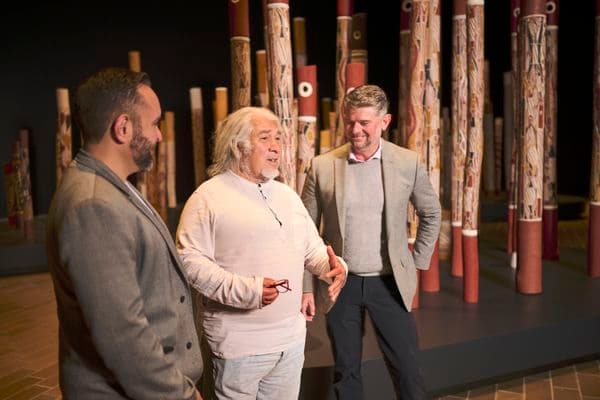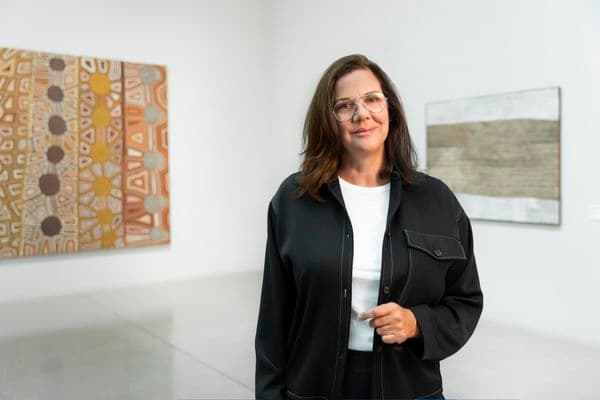The Aboriginal Memorial

Ramingining artists, Djon Mundine, Bandjalung people, The Aboriginal Memorial, 1987–88, purchased with the assistance of funds from National Gallery admission charges and commissioned in 1987
The Aboriginal Memorial – 30th Anniversary
Djon Mundine, conceptual producer, introduces 'The Aboriginal Memorial' (1987–88) by Ramingining artists.
About

David Blanasi, Rembarrnga people, Plants, fish and body designs in four bands, 1987–88, purchased with the assistance of funds from National Gallery admission charges and commissioned in 1987
The Aboriginal Memorial is an installation of 200 hollow log coffins from Central Arnhem Land. It commemorates all the Indigenous people who, since 1788, have lost their lives defending their land. The artists who created this installation intended that it be located in a public place where it could be preserved for future generations.
The path through the Memorial imitates the course of the Glyde River estuary which flows through the Arafura Swamp to the sea. The hollow log coffins are situated broadly according to where the artists' clans live along the river and its tributaries.
The different painting styles apparent in groupings are related to the artists' social groups (sometimes described as clans) which link people by or to a common ancestor, land, language and strict social affiliations.
The people of Central and Eastern Arnhem Land refer to themselves collectively as Yolngu, meaning human beings. All clans belong to a moiety i.e. one of two complementary halves of society: Dhuwa and Yirritja. All such affiliations play a part in Aboriginal artists' inherited right to paint an established set of designs belonging to their social group; this inheritance is, in fact, the artist's copyright over imagery.
In Arnhem Land, the right to paint is usually inherited patrilineally, although many artists paint their mother's story too. The designs on the hollow logs in the Memorial are the same themes that these artists paint on bark and on people's bodies in ceremony.
Hollow logs made for a burial ceremony are large. Smaller hollow logs may be made to keep the bones of the deceased at the home of the family for a period of time. The hollow logs can also represent the deceased person — the designs on the log are the same as the designs painted on the body during the burial rites. Many of the hollow logs have a small aperture either carved or painted towards the top. Yolngu believe that this provides the soul of the deceased with a viewing hole to look through and survey the land.
Yolngu believe that to achieve a shimmering brilliance in painting through cross-hatching and line work — giving a 'singing' quality to the imagery — is to evoke ancestral power. Artists from nine groups worked on the Memorial, and, whilst clan designs follow strict conventions ruling subject matter, each individual artist's hand is apparent.
As you move through the Memorial, you will witness the imagery from changing environments, from the lands of the saltwater people further inland to the country of the freshwater people.
The natural environment and its phenomena are vital to the Yolngu's clan identity. 'We Yolngu belong to different barpurru [clan groups] and each barpurru paints things differently; it depends if you come from the gulunbuy [mangroves] or diltjipuy [forests] or rangipuy [beach] ... It's important to know the difference and we need to teach the young people to paint in this way because they don't know. I teach them by painting a picture so they learn to see the difference,' says George Malibirr.
The work is unified by an array of common themes: the celebration of life, respect for the dead and mortuary traditions and people's connection with ancestral beings. Themes of transition and regeneration within Aboriginal culture pervade the Memorial. On a wider scale, the Memorial also marks a watershed in the history of Australian society. Whilst it is intended as a war memorial, it is also a historical statement, a testimony to the resilience of Indigenous people and culture in the face of great odds, and a legacy for future generations of Australians.
In June 2022 The Aboriginal Memorial reopened in a new location in the heart of the Gallery on Level 1. The relocation was planned in close consultation with the Ramingining community and the Commissioning Curator of the work, Djon Mundine. The new presentation returns the work to its original rectangular format as per the artists’ intent.
Acknowledgments
The authors and the National Gallery of Australia gratefully acknowledge the following for assistance in producing this web site: Bula'bula Arts, Ramingining and Maningrida Arts and Culture, Dr Ian Keen and Dr Luke Taylor for information on the stories of clans. Warwick Smith for the data on species. Peter McKenzie, Djon Mundine, Belinda Scott, Susan Jenkins, Nigel Lendon, Jon Lewis and Jon Altman for permission to reproduce their photographs.

///national-gallery-of-australia/media/dd/images/20220531__Memorail_Poles_Installs07.jpg)














